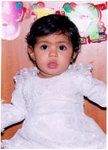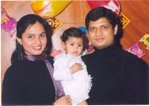Some foods are not good for you during pregnancy. For various reasons, they affect your foetus badly and your chances of carrying the pregnancy to term reduce greatly.
Here is a list of the things I was told to avoid.
Papaya: In India, traditionally, when a lady found out she was pregnant and did not want the child (pre-birth-control era and in rural areas), she would eat papaya. Nowadays it is said that the papaya seed has hormones that cause abortions in the early stages of pregnancy. The problem is that when you eat a papaya, some of the seeds are still forming and so are difficult to avoid ingesting along with the pulp. To simplify things, I just stayed FAR away from papayas the entire time that I was pregnant.
Sugar Cane Juice & Sugar Cane: Because of the way it is harvested and stored in India, sugar canes and their juice have a very high bacterial content. These bacteria can cause severe infections which can lead to termination of pregnancy.
Ajino Moto (MSG): Ajino Moto is a flavouring used by cooks to make chinese food taste better. It is usd by chefs in all restaurants, large and small quite indiscriminately. Ajino Moto or Mono Sodium Glutamate is a carcinogen (it causes cancer) and is just not good for human consumption. However, in the small quantities present in your Chinese food, it does not immediately harm and adult. The important thing to keep in mind, though is that a dose that is not lethal for an adult may well be so for a foetus. Even if it causes no immediate harm, it may cause long lasting damage that will surface only later. Why take a chance?
Pineapples: For some reason, this fruit tends to cause a lot of allergies and is best avoided in pregnancy.
Saunf / Dil: I don't know if this is an old wives' tale, but I was told to avoid saunf at all costs, as it was too heaty and not good for the baby especially its complexion.
Generally speaking, have foods that are cooling and avoid excess of heaty foods. Have plenty of fruit and vegetables. Keep your nutrition levels high. You don’t need a lot of fat in your diet. Eat healthy. Enjoy eating.
Monday, February 26, 2007
Friday, February 23, 2007
First outside Feed For babies Recipe
The all-important first-outside-feed for the baby! The first time your baby will taste outside food. It is an exciting time and an anxious time. You want to do it very right.
So what do you give your baby at this important moment?
Some things to keep in mind:
Any Milk other than mother's milk is difficult for your baby to digest. Avoid milk.
Honey contains microbes that children below 1 year are not immune to. This could lead to infections.
Avoid any uncooked food because you cannot control the germs in them.
Here's a simple recipe that you can make at home, with your own hands and can control the quality! Your baby deserves nothing but the best!
Ingredients:
4tsp Mung Dal
4tsp Rice
Water as required
Directions:
Take 4 teaspoons of mung dal (Green Gram lentils) and four teaspoons of rice.
Roast this till the mung begins to turn reddish or develops red flecks.
Cool it till it comes to room temperature.
Now powder this in your mixer till it forms a homogeneous and fine powder.
(This powder can be stored for a few days in an airtight container.)
Take one teaspoon of this powder and mix with water till the mixture is of thin pouring consistency.
Boil this mixture for 2 - 3 minutes. Add water if necessary.
The mixture should be such that it easily flows out of the spoon.
Cool this till it is at room temperature and feed this to your baby.
Ideally feed your baby sometime in the morning. Also make sure you are not feeding your baby for the first time on a Sunday. The idea is to be able to access your baby's doctor in case the outside food does not agree with your baby for whatever reason.
Make sure to give your baby a little water after you have fed her and be sure to clean your baby's mouth well after the feed.
Repeat the same feed for a couple of days giving your baby's digestive system time to adjust to this new food. After that you can introduce one new thing at a time. Always give your baby's system time to adjust to any changes in the diet by introducing only one new ingredient at a time and repeating the same recipe at least twice before making any further changes. Do this for about a month and then you can make changes slightly faster.
This is your baby's first step to growing independent of your milk! Cherish the moments as best as you can!
So what do you give your baby at this important moment?
Some things to keep in mind:
Any Milk other than mother's milk is difficult for your baby to digest. Avoid milk.
Honey contains microbes that children below 1 year are not immune to. This could lead to infections.
Avoid any uncooked food because you cannot control the germs in them.
Here's a simple recipe that you can make at home, with your own hands and can control the quality! Your baby deserves nothing but the best!
Ingredients:
4tsp Mung Dal
4tsp Rice
Water as required
Directions:
Take 4 teaspoons of mung dal (Green Gram lentils) and four teaspoons of rice.
Roast this till the mung begins to turn reddish or develops red flecks.
Cool it till it comes to room temperature.
Now powder this in your mixer till it forms a homogeneous and fine powder.
(This powder can be stored for a few days in an airtight container.)
Take one teaspoon of this powder and mix with water till the mixture is of thin pouring consistency.
Boil this mixture for 2 - 3 minutes. Add water if necessary.
The mixture should be such that it easily flows out of the spoon.
Cool this till it is at room temperature and feed this to your baby.
Ideally feed your baby sometime in the morning. Also make sure you are not feeding your baby for the first time on a Sunday. The idea is to be able to access your baby's doctor in case the outside food does not agree with your baby for whatever reason.
Make sure to give your baby a little water after you have fed her and be sure to clean your baby's mouth well after the feed.
Repeat the same feed for a couple of days giving your baby's digestive system time to adjust to this new food. After that you can introduce one new thing at a time. Always give your baby's system time to adjust to any changes in the diet by introducing only one new ingredient at a time and repeating the same recipe at least twice before making any further changes. Do this for about a month and then you can make changes slightly faster.
This is your baby's first step to growing independent of your milk! Cherish the moments as best as you can!
Friday, February 9, 2007
Breastfeeding
Hi!
Just the other day, I realized that not everyone knows much about breastfeeding.
All that "it-comes-to-you-naturally" stuff doesn't happen in real life. Also, most often your own Mums have had babies so long ago, they are not expected to remember all the details! So what ends up happening is that you get bombarded with often conflicting, well meant advice and you are more at sea than you were before!
Having gone through the process of trial and error, here are some tips I'd like to pass on.
1. Start preparing when you are pregnant.
Before the baby is born, make sure you oil your nipples well. Many people have dry skin during pregnancy and while we pay ample attention to the skin on our face and hands, your nipples need attention now. Oiling them and keeping them moisturised goes a long way in making it easier when your baby is born.
Take "Shatavari Kalp" (Ayurvedic herbal drink) with a glass of milk in the ninth month of your pregnancy. This will ensure that you have enough milk for your baby when she is born. Shatavari Kalp will be available at many chemist shops and will definitely be available in Ayurvedic shops or shops that sell herbs.
2. The First Feed.
If you've had a normal delivery, your baby will be brought to you soon after you have settled down in your room after the delivery. If you have had a Cesarean, your baby may be brought to after your anaesthesia has worn off a bit. Again, if you have been given spinal anaesthesia during your delivery, you will be advised by your doctor not to over on your side for 24 hours. In such a case, have a pillow placed by your side lengthwise and place your baby on the pillow so she can reach your breast without having to turn over. You will need to have someone watching so the baby doesn't accidentally roll off the pillow.
3. The Actual Feeding.
Ideally, your baby should have maximum skin contact with you while feeding. It helps to make the baby feel warm and secure. It goes a long way in developing the mother-baby bond. Personally, I found that touching and holding my baby while feeding her also helped me to cope better with my post-surgery pain.
Some Facts:
Your baby may sleep off while feeding. If you feel she hasn't had enough milk, gently rub her cheek or her ears or the back of her head to wake her. Do NOT shake your baby at all. Do NOT pat your baby.
Your baby does get tired sucking. All her mouth muscles may pain with all the hard work they go through getting milk. She may take small gaps while feeding. Allow her those gaps. Be patient.
Your baby may get a small sucking blister on her lips because of the friction between her lips and your breast initially. This will stop when she is more used to drinking milk.
Your nipples may feel very sore initially. There are many creams available that you can apply to alleviate your pain. Your doctor should be bale to help you with a prescription. If you feel too much pain or experience bleeding nipples, you could use a breast shield. The important thing is to openly communicate with your doctor about all discomfort.
Your breast milk is almost 90% water (my Doctor friend told me this). Drink at least 2 litres of fluids so you have enough milk.
If you feel you are not having enough milk for your baby, talk to your doctor. She may prescribe medicines which help in generating milk. Alternatively, you could try "Shatavari Kalp" an ayurvedic medicine. It is made of Asparagus and is miraculous in its effectiveness. There are many other options available to help lactation. Talk to your doctor about them.
As your baby grows, you will find that you have both developed an understanding of what is best for you. Do not hesitate to experiment (within reasonable limits) with different positions and grips for the two of you.
When my baby was very tiny, I preferred feeding her while sitting in a chair with armrests and holding her so her spine was along my arm and my palm was near her bottom. Slowly, this changed and now at 14 months, it is most convenient to feed her while both of us are lying down.
See what works best for you and enjoy it! Also share it with us, so some weary mother can get some help when it is her turn to feed her baby!
Just the other day, I realized that not everyone knows much about breastfeeding.
All that "it-comes-to-you-naturally" stuff doesn't happen in real life. Also, most often your own Mums have had babies so long ago, they are not expected to remember all the details! So what ends up happening is that you get bombarded with often conflicting, well meant advice and you are more at sea than you were before!
Having gone through the process of trial and error, here are some tips I'd like to pass on.
1. Start preparing when you are pregnant.
Before the baby is born, make sure you oil your nipples well. Many people have dry skin during pregnancy and while we pay ample attention to the skin on our face and hands, your nipples need attention now. Oiling them and keeping them moisturised goes a long way in making it easier when your baby is born.
Take "Shatavari Kalp" (Ayurvedic herbal drink) with a glass of milk in the ninth month of your pregnancy. This will ensure that you have enough milk for your baby when she is born. Shatavari Kalp will be available at many chemist shops and will definitely be available in Ayurvedic shops or shops that sell herbs.
2. The First Feed.
If you've had a normal delivery, your baby will be brought to you soon after you have settled down in your room after the delivery. If you have had a Cesarean, your baby may be brought to after your anaesthesia has worn off a bit. Again, if you have been given spinal anaesthesia during your delivery, you will be advised by your doctor not to over on your side for 24 hours. In such a case, have a pillow placed by your side lengthwise and place your baby on the pillow so she can reach your breast without having to turn over. You will need to have someone watching so the baby doesn't accidentally roll off the pillow.
3. The Actual Feeding.
Ideally, your baby should have maximum skin contact with you while feeding. It helps to make the baby feel warm and secure. It goes a long way in developing the mother-baby bond. Personally, I found that touching and holding my baby while feeding her also helped me to cope better with my post-surgery pain.
- Place your baby so you are both facing each other with the baby's mouth at your breast.
- If you can, put your arm around your baby.
- Let your baby open her mouth wide and latch on to your breast. Make sure that your nipple and areola (brown portion around the nipple) are in your baby's mouth. The baby's lips should be outside her mouth and visible around your breast.
- Don't hesitate to detach your baby and go through this process again till you both get it right.
- If your baby gets only the nipple in her mouth, she will be unable to get a good enough flow of milk and will cry out of frustration. Your nipples will get very sore very soon and you will find all future feeds painful, so get it right.
- From there on, your baby will be able to suck the milk in.
- Allow her to feed from one breast for a maximum of 15 minutes by the clock and then change over to the other breast.
- Hold your breast with your fingers in a "C"shape for all this (Thumb and index finger forming a "C" around your breast.")
- If you want to detach your baby, make sure your fingers are clean and slip your little finger into the baby's mouth to break the suction and then pull your breast out.
Some Facts:
Your baby may sleep off while feeding. If you feel she hasn't had enough milk, gently rub her cheek or her ears or the back of her head to wake her. Do NOT shake your baby at all. Do NOT pat your baby.
Your baby does get tired sucking. All her mouth muscles may pain with all the hard work they go through getting milk. She may take small gaps while feeding. Allow her those gaps. Be patient.
Your baby may get a small sucking blister on her lips because of the friction between her lips and your breast initially. This will stop when she is more used to drinking milk.
Your nipples may feel very sore initially. There are many creams available that you can apply to alleviate your pain. Your doctor should be bale to help you with a prescription. If you feel too much pain or experience bleeding nipples, you could use a breast shield. The important thing is to openly communicate with your doctor about all discomfort.
Your breast milk is almost 90% water (my Doctor friend told me this). Drink at least 2 litres of fluids so you have enough milk.
If you feel you are not having enough milk for your baby, talk to your doctor. She may prescribe medicines which help in generating milk. Alternatively, you could try "Shatavari Kalp" an ayurvedic medicine. It is made of Asparagus and is miraculous in its effectiveness. There are many other options available to help lactation. Talk to your doctor about them.
As your baby grows, you will find that you have both developed an understanding of what is best for you. Do not hesitate to experiment (within reasonable limits) with different positions and grips for the two of you.
When my baby was very tiny, I preferred feeding her while sitting in a chair with armrests and holding her so her spine was along my arm and my palm was near her bottom. Slowly, this changed and now at 14 months, it is most convenient to feed her while both of us are lying down.
See what works best for you and enjoy it! Also share it with us, so some weary mother can get some help when it is her turn to feed her baby!
Subscribe to:
Comments (Atom)


